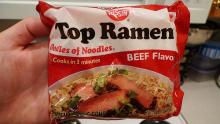Ramen: the butt of so many culinary jokes. (And rightfully so.) Ramen is the canonical food of college students: it's cheap, high in calories, and easy to prepare.
1. Cultural Stigmas Re: Ramen and Poverty
For some reason, culturally we stigmatize college students as Ramen-eaters, and not the working poor. The working poor we stigmatize as being consumers of McDonalds and of candy bars. I don't think I've ever heard someone make a ramen joke about poor people. Doritos, Little Debbie, and McDonalds? Sure. But not so much ramen.
(You could probably speculate up some pretty interesting theories about America's class system out of that observance. I'm drawing a blank, personally. I merely observe, and move on.)
2. Ramen In A Global Context
In Asia, particularly in Japan, ramen is a completely different food stuff. They have whole entire restaurants devoted to ramen, the way we do to pizza or cheeseburgers. They put great stuff on it, and use real noodles.
Ramen in Asia is nothing like Ramen in the United States. Here, it is a degenerate food, fit only for the most hapless members of our society.
3. Ramen In A Cultural Vacuum
Ramen gets a bad rap, but I'll tell you what: it's pretty tasty. Try a packet and see if you don't secretly agree with me. (It's okay, I won't tell anyone!)
It's the cultural baggage that really handicaps ramen as a food.
4. Which Kind?
As a broad generalization, you have to choose between the kind that comes in its own foam cup or bowl, and the kind that you have to boil in a pan.
If you have access only to a microwave or an electric kettle (or the red tap on an office water cooler) then you are pretty much stuck with the in-its-own-cup (Cup 'O Noodles) kind. This is a pity, because this kind is inferior in almost every respect. The noodles aren't as toothsome, it includes flecks of dried vegetable which are somewhat unpleasant, and how the heck are you supposed to close that flap, anyway?
If you have the relative luxury of being able to boil water in a pan, the packet kind (epitomized by Top Ramen) is far superior. Less packaging waste, as well.
5. Nutritionally?
Oh, nutritionally speaking, it's terrible. One packet of Top Ramen contains 14 grams of fat, 52 grams carbohydrates, and 1,820 mg sodium (75% of your RDV).
It's darned tasty, though. Anything that bad for you would kinda have to be, don't you think?
1. Cultural Stigmas Re: Ramen and Poverty
For some reason, culturally we stigmatize college students as Ramen-eaters, and not the working poor. The working poor we stigmatize as being consumers of McDonalds and of candy bars. I don't think I've ever heard someone make a ramen joke about poor people. Doritos, Little Debbie, and McDonalds? Sure. But not so much ramen.
(You could probably speculate up some pretty interesting theories about America's class system out of that observance. I'm drawing a blank, personally. I merely observe, and move on.)
2. Ramen In A Global Context
In Asia, particularly in Japan, ramen is a completely different food stuff. They have whole entire restaurants devoted to ramen, the way we do to pizza or cheeseburgers. They put great stuff on it, and use real noodles.
Ramen in Asia is nothing like Ramen in the United States. Here, it is a degenerate food, fit only for the most hapless members of our society.
3. Ramen In A Cultural Vacuum
Ramen gets a bad rap, but I'll tell you what: it's pretty tasty. Try a packet and see if you don't secretly agree with me. (It's okay, I won't tell anyone!)
It's the cultural baggage that really handicaps ramen as a food.
4. Which Kind?
As a broad generalization, you have to choose between the kind that comes in its own foam cup or bowl, and the kind that you have to boil in a pan.
If you have access only to a microwave or an electric kettle (or the red tap on an office water cooler) then you are pretty much stuck with the in-its-own-cup (Cup 'O Noodles) kind. This is a pity, because this kind is inferior in almost every respect. The noodles aren't as toothsome, it includes flecks of dried vegetable which are somewhat unpleasant, and how the heck are you supposed to close that flap, anyway?
If you have the relative luxury of being able to boil water in a pan, the packet kind (epitomized by Top Ramen) is far superior. Less packaging waste, as well.
5. Nutritionally?
Oh, nutritionally speaking, it's terrible. One packet of Top Ramen contains 14 grams of fat, 52 grams carbohydrates, and 1,820 mg sodium (75% of your RDV).
It's darned tasty, though. Anything that bad for you would kinda have to be, don't you think?
